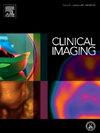Safety and efficacy of percutaneous transluminal angioplasty for residual venous stenosis after surgical decompression in venous thoracic outlet syndrome
IF 1.5
4区 医学
Q3 RADIOLOGY, NUCLEAR MEDICINE & MEDICAL IMAGING
引用次数: 0
Abstract
Purpose
To evaluate the safety and efficacy of percutaneous transluminal angioplasty (PTA) performed within 90 days to treat residual venous stenosis following surgical decompression for venous thoracic outlet syndrome (vTOS).
Materials and methods
In this institutional review board (IRB)-approved retrospective study, patients who underwent percutaneous transluminal angioplasty within 90 days of surgical decompression for venous thoracic outlet syndrome between January 2000 and December 2023 were included. Following surgery, patients underwent post-operative venography within 90 days, and percutaneous transluminal angioplasty was performed if there was radiographic evidence of subclavian venous stenosis. Post-angioplasty, patients were followed clinically, and venography was performed if symptoms recurred.
Results
We found 133 patients (mean age = 31.7 years, 54 males) who underwent percutaneous transluminal angioplasty within 90 days of surgical decompression for venous thoracic outlet syndrome. Two patients in our study had bilateral symptoms and underwent bilateral surgical decompression followed by bilateral angioplasty. Percutaneous transluminal angioplasty was technically successful in 127/135 (94.1 %) extremities. In eight (5.9 %) extremities, the venous occlusion could not be crossed. There were no adverse events from the percutaneous angioplasty procedure. Twenty (15.7 %) extremities developed recurrent symptoms at a median of 162 days following percutaneous angioplasty, and venography confirmed the recurrent venous stenosis.
The primary patency rates following percutaneous transluminal angioplasty at 6, 12, 36, 60, and 84 months were 92 %, 86 %, 85 %, 84 %, and 83 % respectively.
Conclusion
Residual venous stenosis following surgical decompression for venous thoracic outlet syndrome can be safely and effectively treated with percutaneous transluminal angioplasty within 90 days to achieve high long-term patency rates.
经皮腔内血管成形术治疗静脉胸廓综合征手术减压后残留静脉狭窄的安全性和有效性
目的评价经皮腔内血管成形术(PTA)治疗胸廓静脉出口综合征(vTOS)术后90天内残存静脉狭窄的安全性和有效性。材料和方法在这项机构审查委员会(IRB)批准的回顾性研究中,纳入了2000年1月至2023年12月期间因静脉胸廓出口综合征接受手术减压90天内经皮腔内血管成形术的患者。术后患者在90天内行术后静脉造影,如有影像学证据显示锁骨下静脉狭窄,则行经皮腔内血管成形术。血管成形术后,对患者进行临床随访,如症状复发则行静脉造影。结果133例患者(平均年龄31.7岁,男性54例)在胸廓静脉出口综合征手术减压后90天内行经皮腔内血管成形术。在我们的研究中,有两名患者出现双侧症状,并接受了双侧手术减压和双侧血管成形术。127/135例(94.1%)肢体经皮腔内血管成形术技术成功。8例(5.9%)下肢静脉闭塞不能交叉。经皮血管成形术无不良事件发生。20例(15.7%)肢体在经皮血管成形术后162天出现复发症状,静脉造影证实静脉狭窄复发。经皮腔内血管成形术后6、12、36、60和84个月的原发性通畅率分别为92%、86%、85%、84%和83%。结论经皮腔内血管成形术治疗胸廓静脉出口综合征术后90天内残存静脉狭窄安全有效,长期通畅率高。
本文章由计算机程序翻译,如有差异,请以英文原文为准。
求助全文
约1分钟内获得全文
求助全文
来源期刊

Clinical Imaging
医学-核医学
CiteScore
4.60
自引率
0.00%
发文量
265
审稿时长
35 days
期刊介绍:
The mission of Clinical Imaging is to publish, in a timely manner, the very best radiology research from the United States and around the world with special attention to the impact of medical imaging on patient care. The journal''s publications cover all imaging modalities, radiology issues related to patients, policy and practice improvements, and clinically-oriented imaging physics and informatics. The journal is a valuable resource for practicing radiologists, radiologists-in-training and other clinicians with an interest in imaging. Papers are carefully peer-reviewed and selected by our experienced subject editors who are leading experts spanning the range of imaging sub-specialties, which include:
-Body Imaging-
Breast Imaging-
Cardiothoracic Imaging-
Imaging Physics and Informatics-
Molecular Imaging and Nuclear Medicine-
Musculoskeletal and Emergency Imaging-
Neuroradiology-
Practice, Policy & Education-
Pediatric Imaging-
Vascular and Interventional Radiology
 求助内容:
求助内容: 应助结果提醒方式:
应助结果提醒方式:


